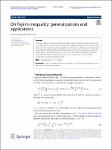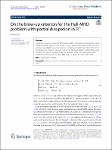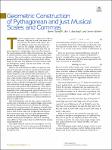Search
Author
- Carlos, Alegría (2)
- Carlos, Seara (2)
- David, Orden (2)
- Klaus, Bretterbauer (2)
- next >
Subject
Date issued
Has File(s)
- true (287)
Search Results
This paper deals with generalizations and refinements of Fejér’s inequality with some new applications. We introduce a real mapping Mωf(t) and obtain some its functional properties. We present several inequalities in connection with fractional integrals and their refinements by monotone functions. We also give some inequalities related to Euler’s gamma and beta functions. Furthermore, we obtain some upper and lower bounds for generalized logarithmic mean and the expected value of random variables by using the arithmetic mean. |
In this paper, we deal with reversing and extended symmetries of subshifts generated by bijective substitutions. We survey some general algebraic and dynamical properties of these subshifts and recall known results regarding their symmetry groups. We provide equivalent conditions for a permutation on the alphabet to generate a reversing/extended symmetry, and algorithms how to compute them. Moreover, for any finite group H and any subgroup P of the d-dimensional hyperoctahedral group, we construct a bijective substitution which generates an aperiodic subshift with symmetry group Zd×H and extended symmetry group (Zd⋊P)×H. A similar construction with the same symmetry group, but with extended symmetry group (Zd×H)⋊P is also provided under a mild assumption on the dimension. |
This paper proposes the use of F-split and globally F-regular conditions in the pursuit of BAB type results in positive characteristic. The main technical work comes in the form of a detailed study of threefold Mori fibre spaces over positive dimensional bases. As a consequence we prove the main theorem, which reduces birational boundedness for a large class of varieties to the study of prime Fano varieties. |
This work is concerned with both higher integrability and differentiability for linear nonlocal equations with possibly very irregular coefficients of VMO-type or even coefficients that are merely small in BMO. In particular, such coefficients might be discontinuous. While for corresponding local elliptic equations with VMO coefficients such a gain of Sobolev regularity along the differentiability scale is unattainable, it was already observed in previous works that gaining differentiability in our nonlocal setting is possible under less restrictive assumptions than in the local setting |
We study global and local geometry of forms on odd symplectic BV supermanifolds, constructed from the total space of the bundle of 1-forms on a base supermanifold. We show that globally 1-forms are an extension of vector bundles defined on the base supermanifold. In the holomorphic category, we prove that this extension is split if and only if the super Atiyah class of the base supermanifold vanishes. This is equivalent to the existence of a holomorphic superconnection: we show how this condition is related to the characteristic non-split geometry of complex supermanifolds. |
In this paper, we investigate the 3D incompressible Hall-magnetohydrodynamics with partial dissipation. Based on the results in (Du in Bound. Value Probl. 2022:6, 2022; Du and Liu in Acta Math. Sci. 42A:5, 2022; Fei and Xiang in J. Math. Phys. 56:051504, 2015), we establish an improved blow-up criterion for classical solutions. Furthermore, using the blow-up criterion, we also obtain the existence of the classical solutions only under the condition that the initial data ∥V0∥H1+∥B0∥H2 are sufficiently small.1 Introduction |
To your average pianist, G-sharp and A-flat are the same. They are located at the same black key between the white G and A keys, but with different names. For other musicians, however, for example violinists, they are different notes. They would claim that the piano represents a compromise, since it is often tuned to the equal-tempered scale, while other musical scales, based on simple harmonic ratios, often appear more harmonious to the ear. This article explains and illustrates this dilemma geometrically. In these scales, G-sharp and A-flat will no longer be the same. The difference between them is called the Pythagorean comma, and the name hints at the long history of music theory. |
We prove a version of the Lebesgue differentiation theorem for mappings that are defined on a measure space and take values into a metric space, with respect to the differentiation basis induced by a von Neumann lifting. As a consequence, we obtain a lifting theorem for the space of sections of a measurable Banach bundle and a disintegration theorem for vector measures whose target is a Banach space with the Radon–Nikodým property. |
In this paper, we propose a first second-order scheme based on arbitrary non-Euclidean norms, incorporated by Bregman distances. They are introduced directly in the Newton iterate with regularization parameter proportional to the square root of the norm of the current gradient. For the basic scheme, as applied to the composite convex optimization problem, we establish the global convergence rate of the order O(k−2) both in terms of the functional residual and in the norm of subgradients. Our main assumption on the smooth part of the objective is Lipschitz continuity of its Hessian. |
Particle systems made up of interacting agents is a popular model used in a vast array of applications, not the least in biology where the agents can represent everything from single cells to animals in a herd. Usually, the particles are assumed to undergo some type of random movements, and a popular way to model this is by using Brownian motion. The magnitude of random motion is often quantified using mean squared displacement, which provides a simple estimate of the diffusion coefficient. However, this method often fails when data is sparse or interactions between agents frequent. |










